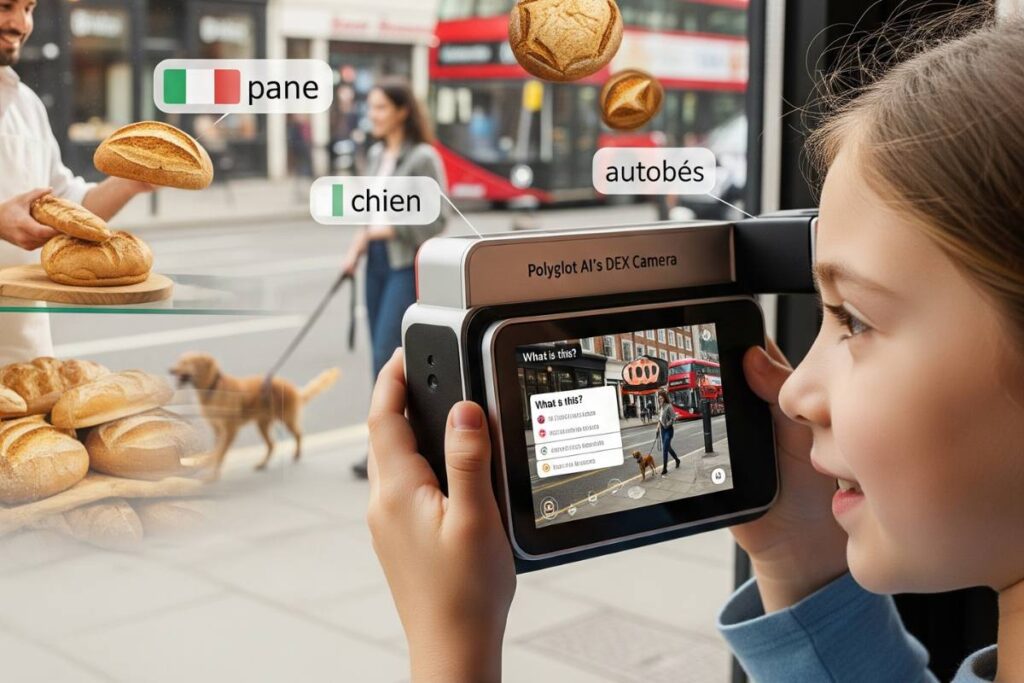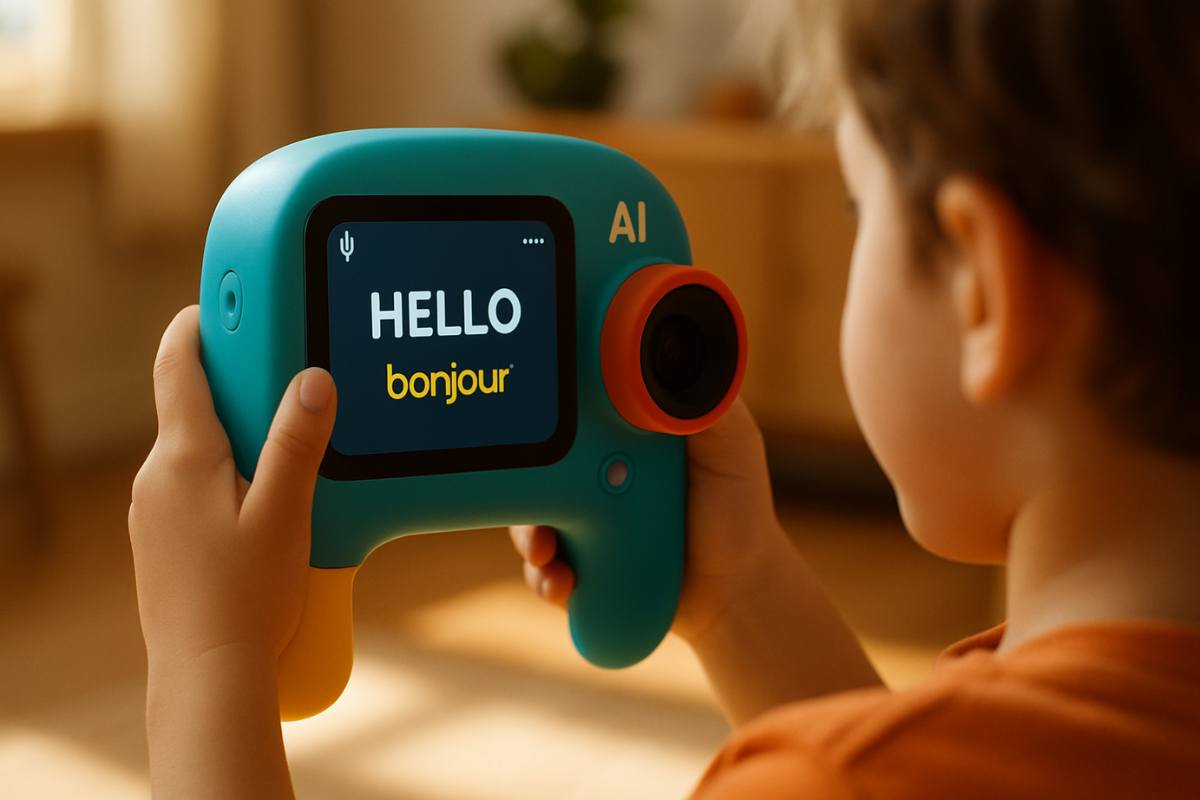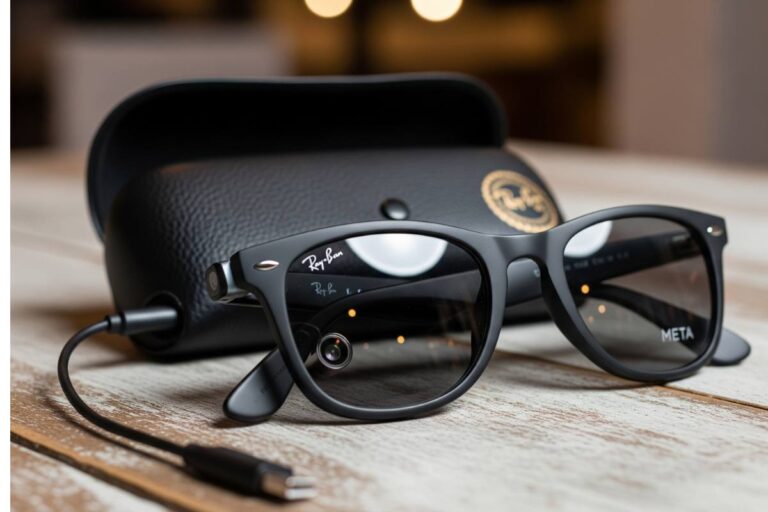SAN FRANCISCO, CA – Every parent knows the dilemma. That modern tightrope walk between wanting to give your child a developmental edge and worrying about the zombie-like trance of excessive screen time. Language apps, educational shows, interactive games hey all live behind the same glass screen. A necessary evil, perhaps.
But what if learning could break free from the tablet?
A new San Francisco-based startup, Polyglot AI, believes it has the answer. And it doesn’t look like an app. It looks like a camera. Meet Dex, a handheld, AI-powered device poised to completely reshape how young children engage with language acquisition. It’s a deceptively simple concept with some seriously complex technology humming just beneath the surface.
This isn’t just another gadget. It’s a bold attempt to bridge the gap between the physical world our children inhabit and the digital tools that promise to enrich it.
Meet Dex: More Than Just a Toy Camera
At first glance, Dex could be mistaken for a durable, brightly-colored toy camera designed for preschoolers. And that’s entirely by design. It’s lightweight, chunky, and built with rugged materials meant to withstand the inevitable drops and tumbles of life with a toddler. There’s a big, friendly lens on the front, an ergonomic grip for small hands, and a single, satisfyingly clickable button.
But here’s the kicker: this is no simple point-and-shoot.
Dex is a window to a multilingual world. A child points the device at an object in their home, a chair, their favorite teddy bear, an apple on the kitchen counter, and presses the button. In an instant, the device’s internal AI whirs to life.
Through a small, built-in speaker, Dex announces the name of the object in a chosen second language, say, Spanish. “Manzana,” a clear, friendly voice says. Simultaneously, the word appears on a small, low-glare E-ink screen on the back, providing crucial text reinforcement for early readers.
The goal? Active engagement. Not passive consumption.
How It Works: The Magic of Point-and-Learn
The process is designed to be intuitive, creating a seamless loop of discovery and reinforcement that, according to its creators, mirrors the natural way children learn their first language. It’s all about context.
Think of it this way: a child doesn’t learn the word “ball” by seeing it on a flashcard on a screen. They learn it by holding a ball, playing with it, and hearing a parent say the word. Dex aims to replicate that organic, tangible connection for a second, third, or even fourth language.
The technology powering this experience is a sophisticated blend of several cutting-edge AI fields:
- Advanced Computer Vision: Dex’s camera feed is processed in real-time by a powerful, on-device computer vision model. This AI has been trained on a massive dataset of household objects, toys, foods, and more, allowing it to identify what it’s “seeing” with remarkable accuracy.
- Natural Language Processing (NLP): Once the object is identified, the device accesses its multilingual lexicon. It’s not just a simple dictionary lookup; the system is designed to use correct articles and pronunciation, delivered via high-quality, text-to-speech synthesis.
- Generative AI Core: Funny thing is, the team at Polyglot AI says the system is more than just a labeler. The underlying AI is generative, meaning it’s capable of learning and adapting. Future updates promise to introduce simple descriptive phrases or even interactive games, all generated contextually based on the child’s environment.
The result is an experience that feels like magic to a child. The world around them suddenly has a new layer of meaning, just waiting to be discovered.
From a Parent’s Problem to a Tech Solution: The Genesis of Polyglot AI

So, where did this idea come from? Like many great innovations, it was born from personal frustration.
Polyglot AI was co-founded by Dr. Elena Vance, a computational linguist and mother of two, and Mark Chen, a former senior AI engineer at a major tech firm. Dr. Vance was determined to raise her children bilingually but found herself increasingly disillusioned with the available tools.
“The apps were the biggest issue for me,” Dr. Vance explained in a recent interview. “They were either glorified video players or tap-and-repeat games that held my kids’ attention for five minutes. They weren’t connecting the new words to their actual lives. The Spanish word for ‘milk’ was just a cartoon on a screen, completely disconnected from the carton of milk in our own fridge.”
She knew there had to be a better way, a way to harness the power of AI without chaining learning to a static tablet or phone. She shared her vision with Chen, a close friend who was grappling with similar concerns about his own son’s screen habits. Chen, you see, was fascinated by the potential of on-device AI and the challenge of shrinking a powerful neural network to fit inside a handheld gadget.
The two worlds collided. Linguistics and engineering. A parent’s need and a technologist’s dream. Polyglot AI was born from that synthesis, driven by a singular mission: to make language learning an active, joyful exploration of the real world.
The Battle Against Passive Screen Time
The timing for Dex’s launch could not be more critical. The debate around screen time for young children has reached a fever pitch, with child development experts and pediatric associations continually revising guidelines. The core concern isn’t necessarily with screens themselves, but with the nature of the interaction.
Passive consumption, watching videos, playing simple tapping games, has been linked to a host of developmental issues, from shortened attention spans to language delays. Active engagement, on the other hand, where a child is thinking critically and physically interacting with their environment, is widely praised.
This is the very ground on which Dex stakes its claim.
It’s a piece of technology that actively encourages a child to get off the couch. To learn the word for “tree,” they have to go outside. To learn the word for “spoon,” they have to walk to the kitchen drawer. The device becomes a catalyst for movement and curiosity, transforming a child’s entire home, backyard, and world into a living classroom.
Dr. David Morrison, a child psychologist not affiliated with the company, commented on the trend. “The principle is sound. We know that embodied cognition, the idea that the mind is profoundly shaped by the body’s interactions with the world, is a powerful force in learning. Tools that encourage children to link a new concept to a physical object and a physical action are tapping into a much more effective educational pathway than purely digital, disembodied methods.”
Dex, if it delivers on its promise, is a prime example of this principle in action.
The Elephant in the Room: A Camera in a Child’s Room
Of course, the idea of an AI-powered camera in a child’s hands immediately raises a big, red flag for any parent. Privacy.
In an age of data breaches and intrusive smart devices, inviting a camera that is constantly “seeing” into your home is a significant ask. The team at Polyglot AI says they understood this from day one and built Dex with a “privacy-first” architecture. It’s a tough nut to crack, but they believe they’ve threaded the needle.
Here’s how they are addressing the privacy question head-on:
- On-Device Processing: This is the most critical feature. According to Chen, the vast majority of AI processing happens directly on the Dex device itself. The image recognition, the language lookup all occur locally. The images your child takes of your living room, your kitchen, or their bedroom are not, he claims, being uploaded to a company server in the cloud.
- Anonymized Data for Improvement: The only data that leaves the device, according to the company’s privacy policy, is anonymized metadata for improving the AI models. For example, the device might report, “An object identified as ‘cup’ with 92% confidence was re-labeled by the parent as ‘mug’.” No images, no user information, no personal data is attached. It’s simply feedback to make the AI smarter for everyone.
- No Microphone: Believe it or not, while Dex has a speaker, it does not have an open microphone. It is not listening. The interaction is one-way: the device speaks to the child, but it doesn’t record ambient audio, protecting family conversations from ever being captured.
- Parental Controls: A companion app (for the parents, not the kids) will allow for robust controls, including setting “off-limits” times and reviewing the types of words their child is learning.
“We built this as parents, for parents,” Chen stated. “The nightmare scenario of private family moments ending up on a server is just as terrifying to us. That’s why we invested so heavily in making the on-device processing powerful enough to handle the core tasks without needing the cloud. It was harder, and it was more expensive, but it was non-negotiable.”
Early Buzz, Market Reception, and What’s Next
Polyglot AI recently closed a $15 million Series A funding round led by prominent venture capital firms known for their investments in EdTech and hardware. This injection of capital signals significant confidence from the market that the company is onto something big.
Dex is slated for a direct-to-consumer launch this November, just in time for the holiday season. Pre-orders went live on the company’s website this week, with an introductory price of $199. At launch, the device will support five languages: Spanish, French, Mandarin Chinese, German, and English, with plans to add more via over-the-air software updates in 2026.
The real question, though, is what comes next.
The team at Polyglot AI sees simple object identification as just the beginning, the first floor of a skyscraper they intend to build. The generative AI core is the key.
Future software updates could unlock incredible new features:
- Interactive Quests: Imagine the device whispering, “Can you find something rojo?” or “Show me the chaise.” This turns learning into a scavenger hunt, further gamifying the experience.
- Simple Sentence Building: After identifying a cat, Dex might offer a simple phrase: “The cat is sleeping.” or “El gato está durmiendo.” This would be a major leap, moving from vocabulary to syntax.
- Storytelling Mode: A child could point to a series of objects, a doll, a car, a book, and Dex could weave them into a simple, generated story using the new vocabulary words.
Ultimately, Polyglot AI doesn’t just want to sell a device; it wants to build a platform. A platform for active, tangible, AI-powered learning that could one day expand beyond languages into other subjects. Imagine a version of Dex for budding scientists, one that can identify different types of leaves, insects, or rocks in the backyard.
The potential is immense.
For now, however, the focus is clear. Dex represents a bold, ambitious challenge to the status quo of educational technology. It’s a bet that parents are desperate for a way to foster learning that encourages their kids to look up from their screens and engage with the rich, wonderful, and complex world right in front of them. The market’s response this holiday season will be the ultimate test.
































